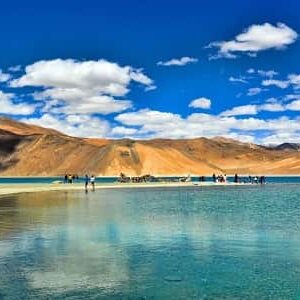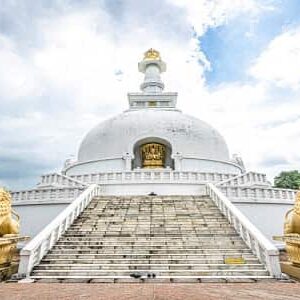Bike riding in Ladakh is a thrilling and adventurous experience that attracts riders from all over the world. Ladakh, a region in the northernmost part of India, offers some of the most breathtaking and challenging terrain for motorbike enthusiasts. Here are some key points to consider if you’re planning a bike ride in Ladakh:
Ladakh offers a unique and challenging riding experience with its stunning landscapes, high-altitude passes, and rich culture. However, it’s crucial to be well-prepared and take safety precautions seriously when embarking on a bike ride in this region.
Bike riding in Ladakh isn’t just an adventure; it’s a soul-stirring odyssey through a land that defies imagination. Nestled in the northernmost reaches of India, Ladakh unveils a world of extraordinary beauty and challenge to those who dare to traverse its rugged terrain on two wheels.
This isn’t your average road trip; it’s a high-altitude escapade that demands grit, resilience, and careful planning. Ladakh’s roads, etched into the Himalayan landscape, twist and turn through towering mountains, plunging valleys, and dramatic landscapes that shift from arid deserts to lush oases. Each hairpin bend promises a new revelation, and every summit conquered leaves you breathless, not just from the thin air, but from the sheer awe of nature’s grandeur.
Riding here isn’t just about the thrill of conquering the world’s highest motorable passes, like Khardung La or Chang La; it’s about surrendering to the serene beauty of Pangong Lake’s azure waters or the spiritual aura of monasteries perched on cliffs.
Your motorcycle becomes your trusted companion, navigating challenging terrains, river crossings, and dusty tracks. But it’s not just about the ride; it’s about immersing yourself in Ladakh’s rich culture, respecting the traditions of its warm-hearted people, and savoring the flavors of traditional Ladakhi cuisine.
Table of Contents
ToggleThings to Check Beffor Bike Riding in Ladakh
Permits: Before you start your journey, make sure to obtain the necessary permits, especially if you plan to visit restricted areas. Check the latest regulations and obtain the permits from the local authorities.
Choose the Right Time: Ladakh is accessible by road only for a few months in the year, usually from May to October, when the snow has melted and the passes are open. The best time for bike riding is from June to September when the weather is relatively stable.
Bike Selection: Ensure your bike is well-suited for the challenging terrain. Popular choices include Royal Enfield Himalayan, Royal Enfield Bullet, and other adventure bikes with good ground clearance.
Maintenance: Thoroughly inspect and maintain your bike before embarking on your journey. This includes checking the engine, brakes, tires, and carrying essential tools and spare parts.
Safety Gear: Always wear appropriate safety gear, including a good quality helmet, riding jacket, gloves, knee guards, and riding boots. Ladakh’s terrain can be unforgiving, so safety should be a priority.
Route Planning: Plan your route carefully, considering the distance between towns and the availability of accommodation and fuel stations. Fuel stations can be sparse in some areas, so it’s essential to carry extra fuel.
Altitude Sickness: Ladakh is at high altitude, and altitude sickness can be a concern. Acclimatize properly by spending a day or two in Leh (the capital of Ladakh) before heading to higher-altitude areas.
Pack Essentials: Carry essentials like water, snacks, a first-aid kit, warm clothing (even in summer), and a map or GPS device. Mobile phone coverage can be limited in remote areas.
Respect Local Culture: Ladakh has a rich cultural heritage, and it’s essential to respect local customs and traditions. Dress modestly and ask for permission before taking photos, especially in rural areas.
Road Conditions: Be prepared for challenging road conditions, including rough, unpaved roads, steep climbs, and river crossings. Some of the famous passes like Khardung La and Chang La are known for their difficult terrains.
Environmental Responsibility: Leave no trace. Dispose of your waste properly, and don’t disturb the fragile ecosystem of the region.
Group or Solo: Decide whether you want to ride solo or in a group. Both have their advantages, but riding with a group can provide additional support in case of emergencies.
Health and Fitness: Ensure you are physically fit for the journey. Riding in high altitudes can be physically demanding.
Best Time to Do Bike Riding in Ladakh
The best time for bike riding in Ladakh is generally from June to September. During this period, the weather is relatively stable, and most of the high-altitude passes and roads are open for travel. Here’s a breakdown of the seasons and what to expect during each:
June: This marks the beginning of the tourist season in Ladakh. The weather is pleasant, with daytime temperatures ranging from 15°C to 25°C (59°F to 77°F) in Leh. The roads are typically clear of snow, and the landscapes are lush and green due to the melting snow. However, some high-altitude passes might still have patches of snow, and it can be a bit crowded with tourists.
July and August: These months are considered the peak of the tourist season. The weather is warm during the day, with temperatures ranging from 20°C to 30°C (68°F to 86°F) in Leh. The roads are mostly clear, making it an ideal time for bike riding. The landscapes are at their most vibrant, with colorful flowers in bloom. Keep in mind that accommodation can be in high demand during this period, so booking in advance is advisable.
September: September is a great time for bike riding in Ladakh as the weather remains pleasant, but the crowds start to thin out. Daytime temperatures range from 15°C to 25°C (59°F to 77°F) in Leh. The landscapes are still beautiful, and you can enjoy the region with a bit more tranquility. Roads and passes are generally open and safe.




